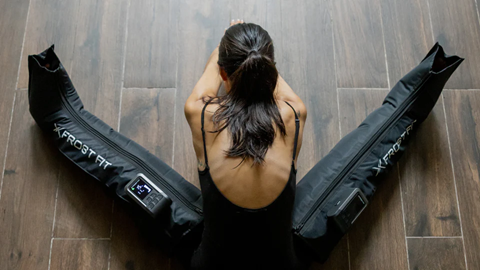Have you ever wondered about athletes’ ability to recover so quickly from intensive training or competition?
Compression boots, those high-tech leg sleeves, are their not-so-secret weapons.
However, these boots aren’t just for the pros. More and more people, from physical therapists to those with poor circulation, are using compression boots for faster recovery and better leg health. They are high-tech devices that rhythmically compress your legs via air pressure, helping blood flow and reducing swelling along with muscle soreness.
In other words, consider them a mechanical massage that works with your body’s natural circulation system.
So, if you’re training hard, recovering from injury, or just on your feet all day, these boots are your go-to tool for effective leg recovery.
Continue scrolling to know more.
This guide breaks down how compression boots help increase circulation and why they’re becoming a necessity in modern recovery.
1. Promoting Venous Return
Promoting efficient venous return is one of the main ways how compression boots improve circulation. These devices squeeze the muscles in your legs rhythmically, using graduated air pressure. It is to simulate the natural muscle contractions that occur during movement. This wave-like compression aids in pushing deoxygenated blood out of the lower limbs and back toward the heart, where it can be re-oxygenated and recirculated.
That means faster venous return, which translates to better overall circulation, meaning your muscles and tissues are receiving a steady supply of fresh oxygen-rich blood. It also helps to reduce blood pooling in the legs, prevent swelling and reduce the risk of chronic venous insufficiency.
This improvement in circulation helps to enhance recovery, comfort, and overall leg health, which are some of the top compression boots benefits. So, investing in a good pair lets you experience this powerful benefit. As a result, each session gets you a step closer to better blood flow and faster recovery.
2. Enhancing Lymphatic Drainage
Not only does wearing compression boots raise blood circulation, but they also support the lymphatic system. It is an important part of your body’s immune and waste removal system.
On that note, the lymphatic system moves lymph fluid away from the tissues, including toxins, waste, and other unwanted materials. However, unlike the cardiovascular system, the lymphatic system has no central pump. It works by depending on the movement of muscles and external pressure to move the fluid.
Therefore, if circulation slows down—such as from inactivity, injury, or surgery—lymph can stagnate, and fluid can build up. In turn, it will lead to swelling and inflammation.
For this reason, compression boots are used to apply gentle, rhythmic pressure to the legs, which helps manually stimulate lymphatic drainage. This movement aims to move lymph fluid to help reduce swelling and remove cellular waste.
It is especially helpful for people with lymphedema or post-surgical swelling. Plus, when used consistently, these boots can provide noticeable relief and make them a practical recovery tool.
3. Increasing Capillary Blood Flow
Another lesser-known yet highly impactful advantage of compression boots is their capacity to increase microcirculation. It is the blood flow through the tiniest blood vessels, i.e., capillaries.
These vessels are responsible for delivering oxygen and essential nutrients directly to muscle cells and tissues. They also help to remove waste products such as carbon dioxide and lactic acid.
In this context, it has been observed that intermittent pneumatic compression increases capillary blood flow dramatically. You can experience this with the compression boots mechanism.
These boots increase microcirculation, allowing your muscles to receive oxygen and nutrients more efficiently. Thus accelerating repair and regeneration—especially after intense activity or injury.
This game-changing enhanced capillary action is great for athletes.
It assists in enhancing muscle recovery, minimizing soreness, and improving overall performance by helping the body’s natural healing process.
Hence, including compression boots in your post-training routine isn’t just for recovery; you’re actually taking steps to help your body heal at a cellular level.
If you have concerns about circulation or vein health, consulting a vein specialist in Royal Oak may provide additional insight and care tailored to your specific needs.
4. Reducing Muscle Fatigue and Soreness

Compression boots’ most appreciated benefits are that they can help reduce muscle fatigue and post-exercise soreness—particularly delayed onset muscle soreness (DOMS). It occurs between 24 and 72 hours after an intense workout.
As a result, it can make even simple movements uncomfortable and slow down your recovery and performance.
However, compression therapy helps to combat this by aiding blood flow to reduce waste materials (such as lactic acid) that accumulate in muscles during exercise. These boots provide rhythmic pressure, facilitate the relaxing of muscles, reduce inflammation, and bring oxygenated blood to accelerate tissue repair.
That means that your legs begin to feel lighter, less stiff and more refreshed after each session.
Due to this muscle relaxation, compression boots have become a favorite recovery tool for runners, cyclists, weightlifters, and endurance athletes.
They’re in the gym pushing their bodies to the limit, and it is a reliable, effective way to regain strength between workout days.
5. Improving Endothelial Function
Apart from immediate recovery benefits, compression boots may also help maintain long-term vascular health.
In this regard, it has been observed that compression therapy actually helps the function of the endothelium—the thin layer of cells that line the inside of your blood vessels.
That said, the endothelium controls blood flow, inflammation reduction, and blood clot prevention by releasing substances to regulate vessel dilation and platelet activity.
So, when endothelial function is impaired, blood vessels are less responsive to signals regarding blood flow, and circulation is weakened. As a result, the risk of cardiovascular issues increases.
In other words, maintaining the health of this function can help with better vascular tone, lower inflammation, and effective circulation throughout your body.
It is especially helpful for people whose blood flow is often compromised due to an underlying condition like diabetes, heart disease, or peripheral artery disease (PAD).
Hence, using compression boots regularly can contribute to more healthy blood vessels, meaning that they are a proactive tool for long-term vascular health.
6. Supporting Post-Surgical Recovery
Compression boots are extremely beneficial for post-surgical recovery, especially after leg and vascular system operations.
It is so because, after surgery, you can have reduced mobility, which can lead to slowed circulation, swelling or blood clots.
However, the pressure of the boots helps stimulate blood flow, reduce fluid buildup, and help tissue heal.
This way, compression boots promote circulation and decrease inflammation, providing a non-invasive, drug-free tool to aid your recovery. It also decreases post-operative complications, making them a smart addition to the recovery process.
Conclusion
Compression boots are more than a recovery trend; they’re a science-backed solution for better circulation, faster healing, and overall wellness.
They help promote venous return, enhance lymphatic drainage and capillary blood flow, reduce muscle soreness, and improve endothelial function.
Therefore, investing in compression boots means investing in your body’s ability to heal, recharge, and thrive.
Get these boots now!






